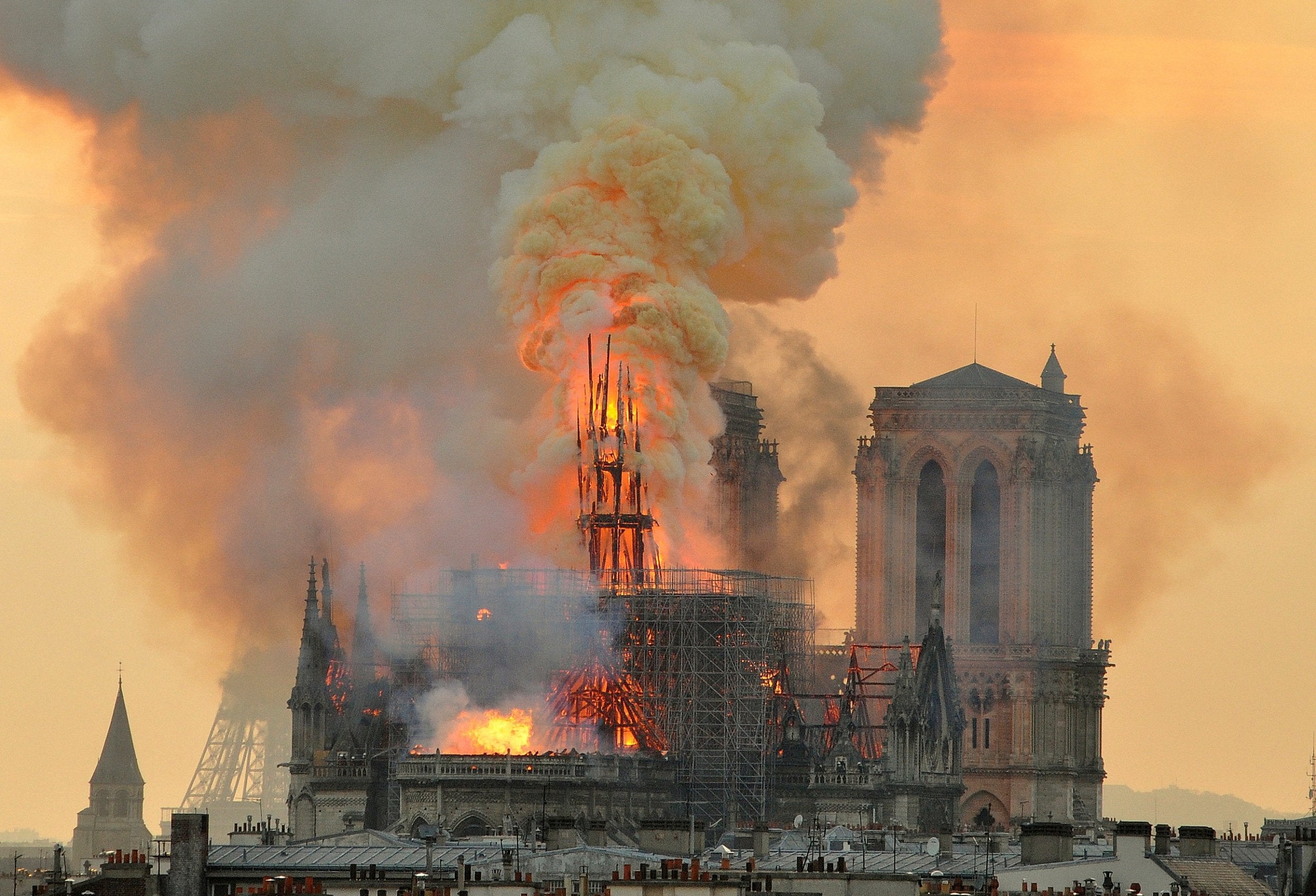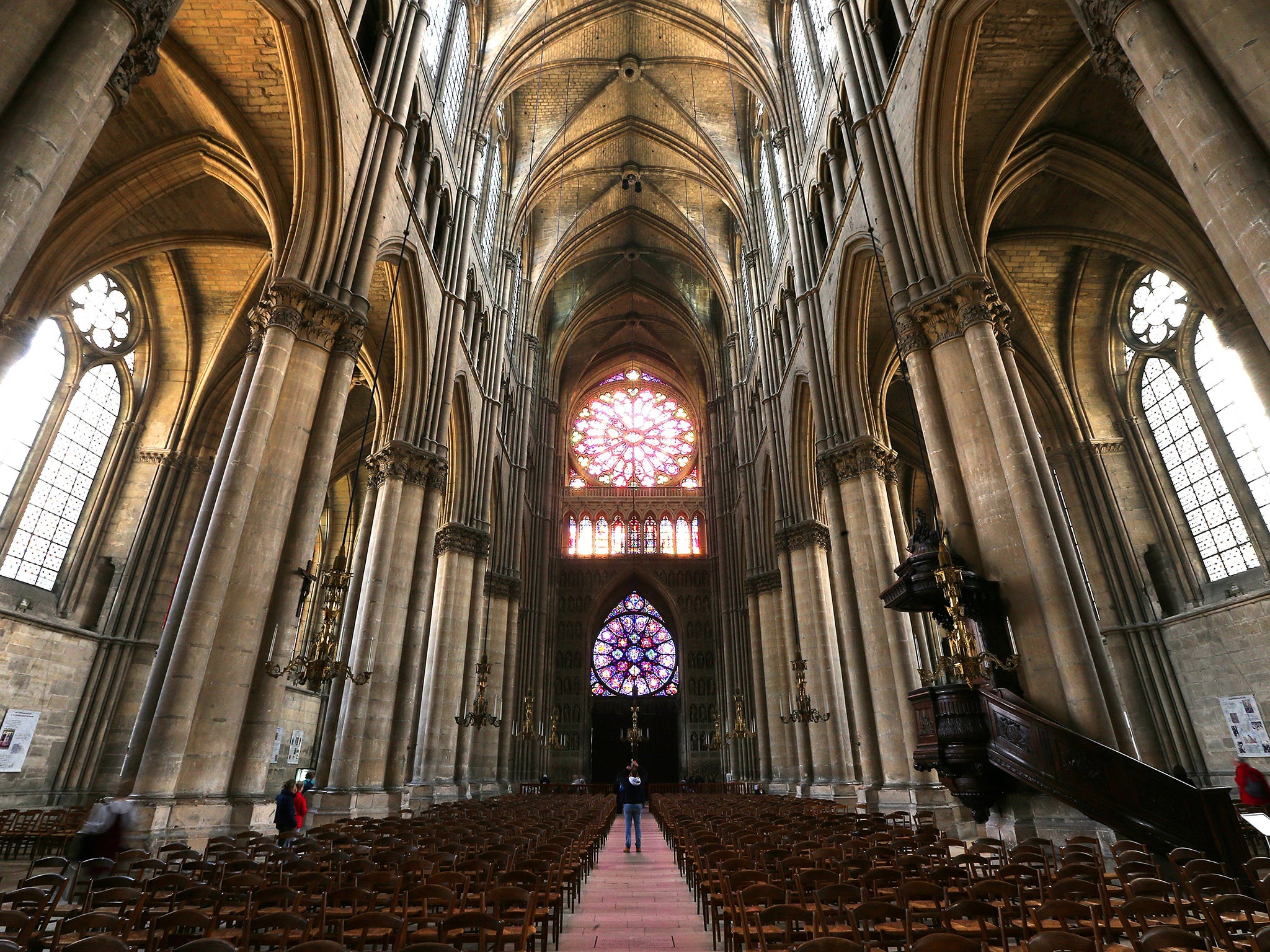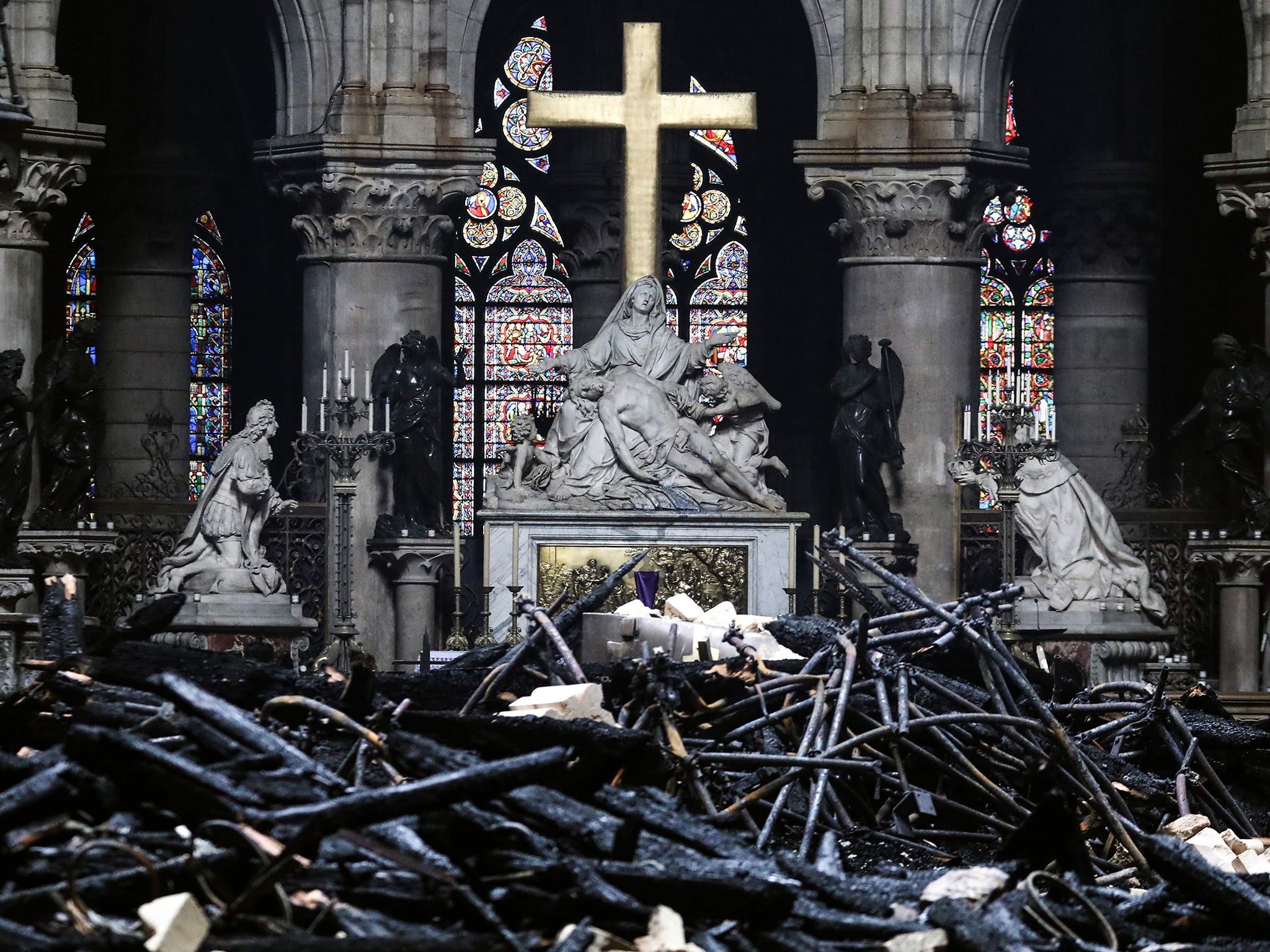What the Notre Dame fire can tell us about the separation of church and state
The establishment of France as a secular state was supposed to put an end to the politicisation and weaponisation of religion. Kevin Childs believes it’s done nothing of the sort. And now the burning of one of France’s most famous religious monuments is likely to reopen old wounds


Paris was burning, or so it seemed. Images of Notre Dame with flames leaping up its twin towers, its old spire crashing down, molten lead dropping, the night sky lit up and the sonorous bells of Saint Sulpice tolling out the apparent death of an architectural icon raced round the world in seconds via social media, registering our horror and fascination through a billion clicks.
Cathedrals, it seems, are made of highly combustible materials. But I expect the conflagration will not just be a matter of a building on fire. Smouldering beneath has been a century-long conflict between church and state in France, which the inevitable blame game will almost certainly reignite. What exactly led to the near catastrophic burning of one of France’s most enduring and popular national monuments?
In a report in 2017 on the parlous state of the fabric decay at Notre Dame, one government official was quoted as saying, “France has thousands of monuments”, suggesting that Paris’s cathedral was not the most pressing case for restoration, “It will not fall down.” Those words will no doubt come back to haunt that unnamed official. They are, in any case, redolent of a sort of laissez-faire attitude towards monuments, and religious monuments in particular.
Unlike in England, church and state in France are officially separated. A process, which began during the revolution of 1789 and the subsequent suppression of the church by revolutionary governments, led to the wholesale confiscation of church properties, including the great cathedrals of France, effectively nationalising the fabric of French Catholicism.
It’s not that something didn’t need to be done. Under the bad old days of the ancien régime the church had been all powerful, fabulously wealthy and preposterously influential over society. A reckoning was inevitable. And then those links between church and state were reforged by Napoleon only to be sundered again when the chamber of deputies passed a law establishing France’s Third Republic as a secular state in 1905. Religion would no longer play a role in state affairs and, more pertinent to the current situation, all church property became state property, cathedrals and chapels being effectively leased back to the Catholic Church for no fee.
Since then, the state has been responsible for the upkeep of churches, chapels, cathedrals and bishops’ palaces constructed before 1905, nominally at least. A hundred years of arguments have ensued with state officials preferring to consider the country’s major cathedrals as museums and the church hierarchy resisting any such denomination. In Paris, Notre Dame had come under the supervision of the ministry of culture, like all the great cathedrals of France, which allocated a mere €2m (£1.7m) a year for restoration of its fabric. Given the terrible state of decay the old church had suffered by 2017, this was clearly nowhere near enough money.
The church authorities believed it was the government’s responsibility, as owners of the cathedral. The government pointed to its agreement with the archdiocese, which stipulated that they were obliged to maintain the building. It was a struggle to find the extra cash to carry out the much needed repairs. One idea to solve the funding crisis was promoted by Emmanuel Macron’s newly appointed heritage fundraiser-in-chief, Stéphane Bern, who suggested that cathedrals like Notre Dame charge a fee for visitors. It did not go down well, a storm of criticism from both clerics and Catholic laity labelling it an infringement of the 1905 law and yet another example of the “commercialisation of our society”. For the time being the initiative has been shelved. In its place a special heritage lottery will provide limited grants for national monuments.
Part of the problem for France’s great cathedrals is that, along with a lack of investment financially, the French people haven’t really invested emotionally in their ancient religious heritage. As Bern put it in a recent interview: “The British have more respect for their patrimony than we French.” Putting aside the undeniable distress of the crowds who watched Notre Dame burn on Monday evening for a moment, visitor figures to the major sites of Reims, Chartres and Amiens show that the vast majority of tourists come from abroad. The same is true of Notre Dame. The French, it seems, don’t really take up the opportunities offered by their magnificent architectural heritage.
That indifference is deep rooted and has been damaging, perhaps the result of a sort of conditioning over two centuries of warfare between secularism and Catholicism. It may have suffered at the hands of militant sans-culottes, but at least Notre Dame survived the worst ravages of the 1790s. Other great medieval churches didn’t fare so well, and the fate of one, the Abbey of Cluny in Burgundy, is a masterclass in state-sponsored iconoclasm. Suppressed by the revolutionary government, arguably the greatest Romanesque church in Europe endured the years of vandalism and warfare intact only to fall victim to property speculators and local builders’ merchants in the 1820s, after the restoration of the Bourbons. With admirable efficiency the stone fabric of the church was dismantled almost entirely and can be found scattered across the town and region. Business and a building boom won out over heritage.
I recently made a decidedly secular pilgrimage to the cathedrals of northern France and was struck by the lack of visitors. Reims Cathedral was like a vast, empty cavern, its joyous painted glass drenching the shadowy interior with empty splendour, none but a handful of tourists to share it. After half an hour or so a crocodile of tiny schoolchildren marched through, dwarfed by their surroundings until even they departed, and the chilly nave returned to what seemed a centuries-old silent contemplation of itself. These are some of the greatest achievements of human skill, ingenuity and artistry, unrivalled anywhere, and they go pretty much unheeded. The wardens and clergy at these sites don’t help, as unfriendly and officious a bunch of guardians as you can get.

It’s true, Notre Dame has suffered from a different problem. More than 13 million visitors a year have taken their toll on the fabric of the building, along with bad weather, pollution and bad renovation. Even before the fire the bill for restoration was eye-watering, coming in at a projected €150m.
It’s no wonder the charge for upkeep gets passed along, with local parish councils hardly bothering to pay for a new church roof, let alone repairing some 12th century glass or an 18th century organ. In real terms, the amount spent by the state on France’s monuments fell by 40 per cent between 2010 and 2017, with private donations falling even more sharply by 50 per cent. Many of the donations that had been made, for the renovations at Notre Dame, for example, came from overseas, principally the US.
To solve cash flow, parish priests have resorted in the past to selling off church furnishings on the sly. Much needed, but often botched, restoration has also been carried out without the legally necessary recourse to the local bureaucracy, and the 50-year-old standoff between clergy and conservators over the reorientation of altars after Vatican II instructed priests to face the congregation has led to odd, ugly, temporary arrangements becoming permanent.
Bern’s pointing to the English example is interesting insofar as we have a heritage industry which is more advanced than France’s and incorporates churches and cathedrals into the national story. Income from visitors is only part of a much more complex and well-established system of revenue generation.
In England, which has effectively a state church, cathedrals are responsible for their own funding, but receive grants and stipends from the Church Commissioners, a body accountable to parliament and the General Synod of the Church of England with an investment fund of more than £8bn. The system works, by and large, but requires cathedrals to be run as businesses, which is something the Catholic Church in France remains hostile to. As an influential religious commentator, Pierre Hervé Grosjean, has maintained, “more than ever we need places of silence, beauty, free of charge, open to all”.
Behind all the toing and froing over responsibility for repairs to national monuments, the debates around the state and its relationship with the Catholic Church can adopt a potentially toxic tone. What limited money that is available for heritage projects from the culture ministry goes mainly to Catholic foundations, while Islamic, Jewish and other Christian denominations compete for the scraps left over. Most churches built before 1905, the cut-off for state ownership, were Catholic. Mosques, synagogues and Protestant churches tend to be later foundations and so are left to their own devices, even having to contend with laws restricting their funding from abroad.

But there is a further dimension to the church-state argument. Recent moves to reemphasise the French republic’s secular foundation – the idea of a watchdog or high authority for secularism was mooted by Deputy Yves Jégo in 2011 – are prompted by the attachment of the far right to the supposed Christian, and specifically Catholic, heritage of France in an attempt to marginalise non-Christian communities and oppose progressive policies such as equal marriage. So for many, the Catholic Church has an image problem. At the time the watchdog was suggested, even President Nicolas Sarkozy was reported extolling France’s “magnificent Christian heritage” in the cathedrals, opining that these were “the France of the roots. This is the France we love.”
And now Notre Dame has become a symbol of, not just Paris, but France itself. President Macron has designated it so, and others have followed. “It’s much more than just a cathedral or tourist attraction, it’s point zero from which all distances are measured in France,” broadcaster Florence Villeminot told the world, “[Notre Dame] is seen as a protective ancestor, a reassuring grandmother.”
Pledges of money, topping €1bn after only two days, will ensure that Notre Dame rises again
And yet, before Monday 15 April 2019, if anyone thought of Paris, I suspect it was a monument like the decidedly secular Eiffel Tower or Arc de Triomphe that came to mind, not Notre Dame. All of this implies a confusion at the heart of France and the heart of French heritage. With dwindling congregations and increasing indifference to religion, what are these great monuments for? Separating church and state was supposed to put an end to the politicisation and weaponisation of religion. It’s done nothing of the sort. And now the burning of one of France’s most famous religious monuments is likely to open up these fissures further.
Pledges of money, topping €1bn after only two days, will ensure that Notre Dame rises again, but the problem at the heart of the French state, at the core of its relationship with religious monuments and religious foundations, with the very notion of religion itself, will not go away because a bunch of billionaires have offered funding for one high-profile project. The government will continue to shirk its responsibilities as landlord and the Catholic Church will continue to shimmy between state and private funding – a piecemeal solution at best, a papering over the cracks at worst – and demand a sort of special status for its historic monuments, emphatically not museums, but not private institutions either.
Politicians point to Italy, where churches have achieved a sort of museum-like role, and yet something is lost in this too. People do need “places of silence … open to all”. Cathedrals have always welcomed everyone, even when their own communities have rejected them, when they are outcasts in spirit as well as body in need of sanctuary. That, after all, is what Victor Hugo’s novel, Notre Dame de Paris, is all about. They are loci of both belonging and anonymity, big enough to hold a world of difference. Recently I was reminded of this when I was told cathedrals are far more welcoming to LGBT+ people, for example, than local parish churches.
It’s a well known topos that the great cathedrals of the 12th and 13th centuries were the result of community effort, they were “people’s churches” as the English writer and scholar Walter Pater called them. In speaking of the effort to restore Notre Dame, Bernard Arnault, chair of LVMH, one of the potential funders of the reconstruction, recognised this: “We need to rebuild collectively this part of our history, our culture. It has to be a collective effort, like it was in the Middle Ages when Notre Dame was first built.”
Human lives in the story of an ancient monument may be short, very short, and we have a commitment to pass the glories of Notre Dame or the cathedrals of Reims and Chartres on to the generations after us so they too have “places of silence”.
Our pact with that longevity means a commitment to pay for it. A building the size of Notre Dame, like Canterbury Cathedral or York Minster, soaks up money. If these cathedrals are to survive, it isn’t just the state’s relationship with them that needs to change, it’s the French public’s. Britain had it’s revolutions a long time ago and over the centuries its rapport with a mildly established church has settled into a sort of 19th-century Barchester Chronicle-like cosiness. The same is not true in France, despite current rhetoric. The revolution feels like recent memory because it is ongoing, and the hostility between church and state is a by-product of that. Adopting Notre Dame as a symbol of rampant nationalism will not help either.
But finding again the spirit that built those great monuments to human ingenuity and capacity for beauty all those centuries ago, the togetherness they ought to foster and represent, the inclusiveness you ought to find, means charting a way to fund their survival that does not rely on disaster to generate interest or nationalism to pervert their meaning to something akin to sacred flag waving.
Join our commenting forum
Join thought-provoking conversations, follow other Independent readers and see their replies
Comments